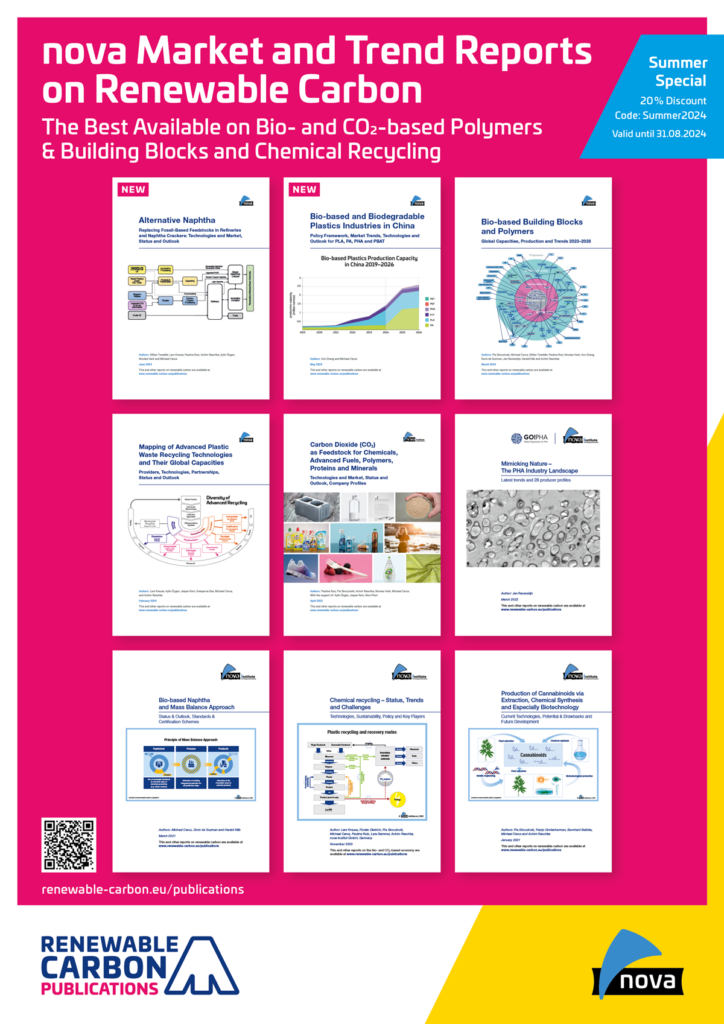
The portfolio of nova-Institute’s market reports covers all relevant topics on renewable carbon. The reports dive deep into feedstocks for the chemical industry from biomass over CO2 to chemical recycling. They provide a comprehensive overview of bio- and CO2-based building blocks and polymers, the advanced recycling landscape, as well as specific renewable building blocks as naphtha, comprehensive analyses of the Chinese bio-based and biodegradability landscape, as well as guidelines, standards and labels for bio-based products. nova-Institute also offers reports on technology, policy, key players and the latest market data available.
The market and trend reports were compiled by nova scientists together with leading international experts and are among the most reliable and recognised sources on the market.
With the allowance code Summer2024 you get a 20% discount on 29 market reports. All reports are available at https://renewable-carbon.eu/commercial-reports.
The offer includes, but is not limited to, the following comprehensive overview reports:

NEW: “Alternative Naphtha – Replacing Fossil-Based Feedstocks in Refineries and Naphtha Crackers: Technologies and Market, Status and Outlook”
For the defossilisation of the chemical industry, it is crucial to find alternatives to fossil-based naphtha. The “alternative naphtha” concept makes use of existing refinery, steam cracking and chemical industry infrastructure where a proportion of fossil-based feedstocks – crude oil or fossil-based naphthas can be replaced by renewable carbon alternatives derived from the three sources of renewable carbon: CO2, biomass and recycling.
This new report by nova-Institute presents an analysis of the routes, associated technologies, market players and volumes by which renewable carbon can be introduced to refinery and steam cracking operations as replacement for fossil-based feedstocks.
NEW: “Bio-based and Biodegradable Plastics Industries in China – Policy Framework, Market Trends, Technologies and Outlook for PLA, PA, PHA and PBAT”
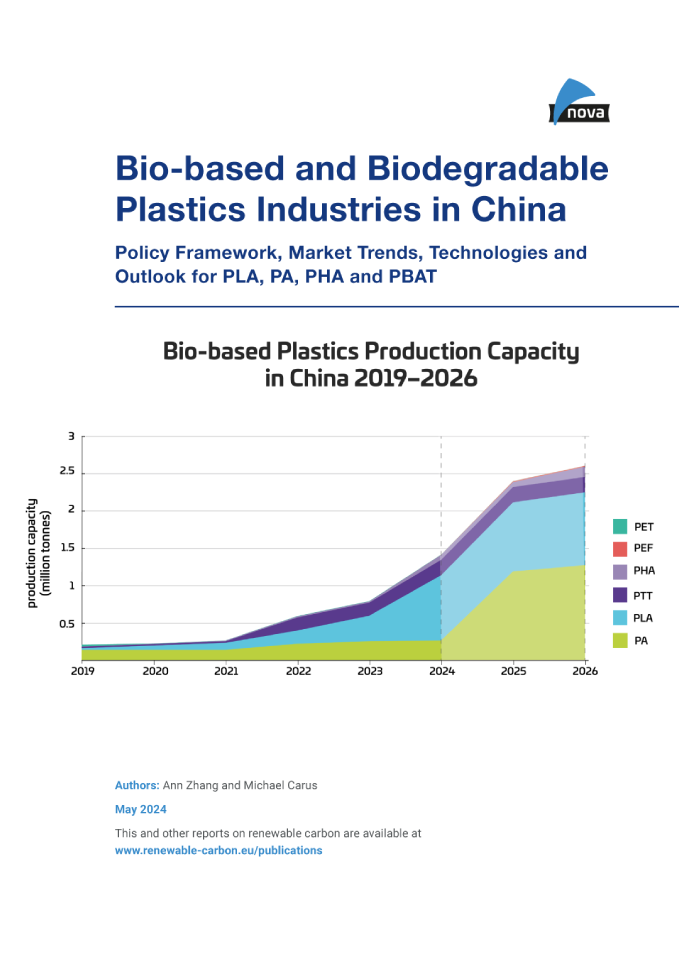
The new report by nova-Institute presents a timely market analysis of China’s bio-based and biodegradable plastics industries and markets in 2024. The report provides an in-depth overview of the key products that dominate the Chinese market. It examines key market trends, policy dynamics, technological advances, key market players and growth opportunities. The aim is to provide chemical companies with actionable insights to navigate the Chinese market effectively and make informed decisions about market expansion or potential partnerships in China. In particular, the report highlights all relevant critical policies in the bio-based and biodegradable plastics markets since 2021 and in the future. It also provides first-hand market insights from Chinese entrepreneurs through in-depth face-to-face interviews with eight Chinese companies.
China’s bio-based plastics industry is experiencing rapid growth despite being in its early stages. This is largely driven by policy incentives. The industry is expected to expand significantly from 765,631 tonnes in 2023 to 2.53 million tonnes in 2026, representing a significant CAGR of approximately 49%.
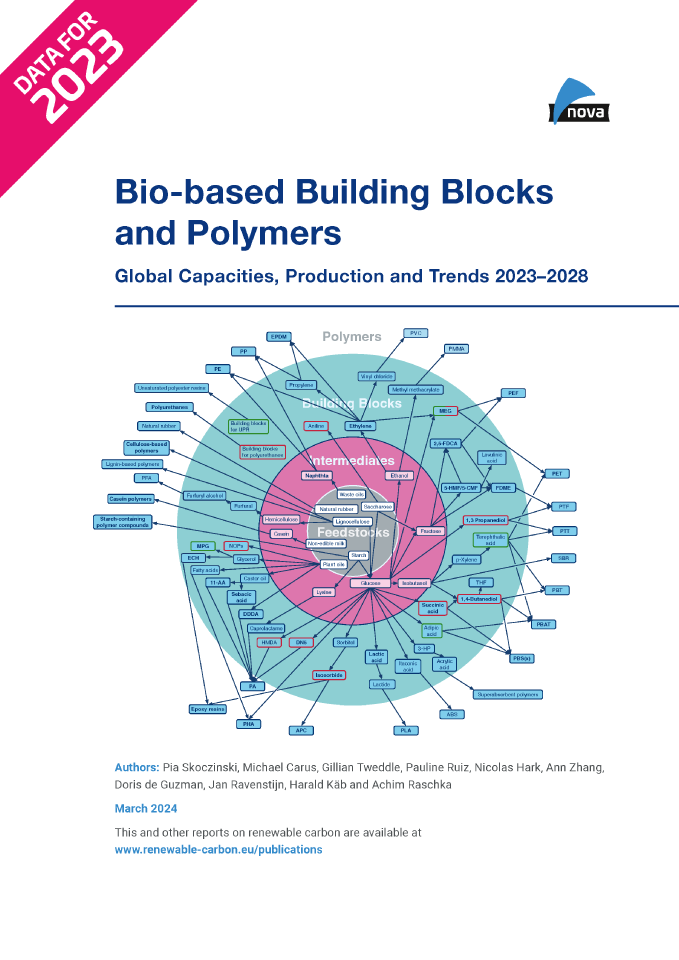
“Bio-based Building Blocks and Polymers – Global Capacities, Production and Trends 2023-2028”
Report on the global bio‑based polymer market 2023 – a deep and comprehensive insight into a dynamically growing market. The year 2023 was a promising year for bio‑based polymers: PLA capacities have been increased by almost 50%, and at the same time polyamide capacities are steadily increasing, as well as epoxy resin production. Capacities for 100% bio-based PE have been expanded and PE and PP made from bio‑based naphtha are being further established with growing volumes. Current and future expansions for PHAs are still on the horizon. After hinting at a comeback in 2022 bio-based PET production dropped in 2023 by 50%.
“Mapping of Advanced Plastic Waste Recycling Technologies and Their Global Capacities – Providers, Technologies, Partnerships, Status and Outlook”
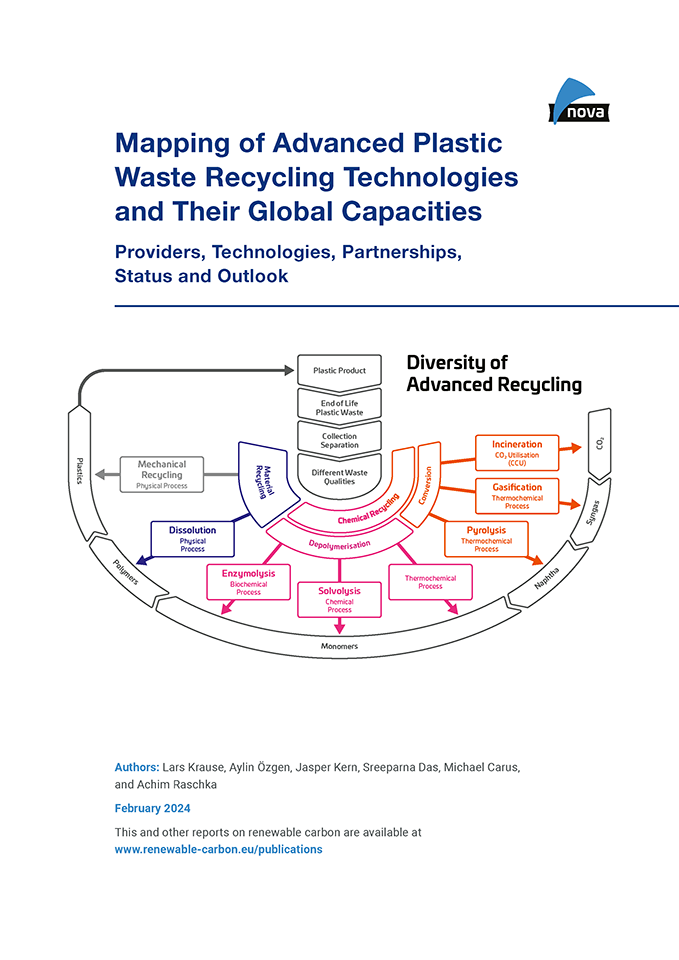
Advanced recycling technologies are developing at a fast pace, with new players constantly appearing on the market, from start-ups to giants and everything in between – new plants are being built, new capacities are being achieved, and new partnerships are established. Due to these developments, it is difficult to keep track of everything. The report “Mapping of advanced plastic waste recycling technologies and their global capacities” aims to clear up this jungle of information providing a structured, in-depth overview and insight. It has an exclusive focus on profiling available technologies and providers of advanced recycling including the addition of new technologies and updated/revised profiles. Furthermore, for the first time a comprehensive evaluation of the global input and output capacities was carried out for which more than 340 planned as well as installed and operating plants including their specific product yields were mapped.
The old report “Chemical Recycling – Status, Trends and Challenges” is suitable for interested readers who have not yet dealt with advanced recycling and are searching for an introduction into the topic while an up-to-date overview of all identified providers is less important. The report includes an extensive introductory part on polymer types, demand of different polymer types, waste fractions, political framework, position papers, technologies, LCAs, associations and waste management companies. Additionally, over 70 technologies and providers as well as respective profiles with updated information of 2020 are shown.
“Carbon Dioxide (CO2) as Feedstock for Chemicals, Advanced Fuels, Polymers, Proteins and Minerals”
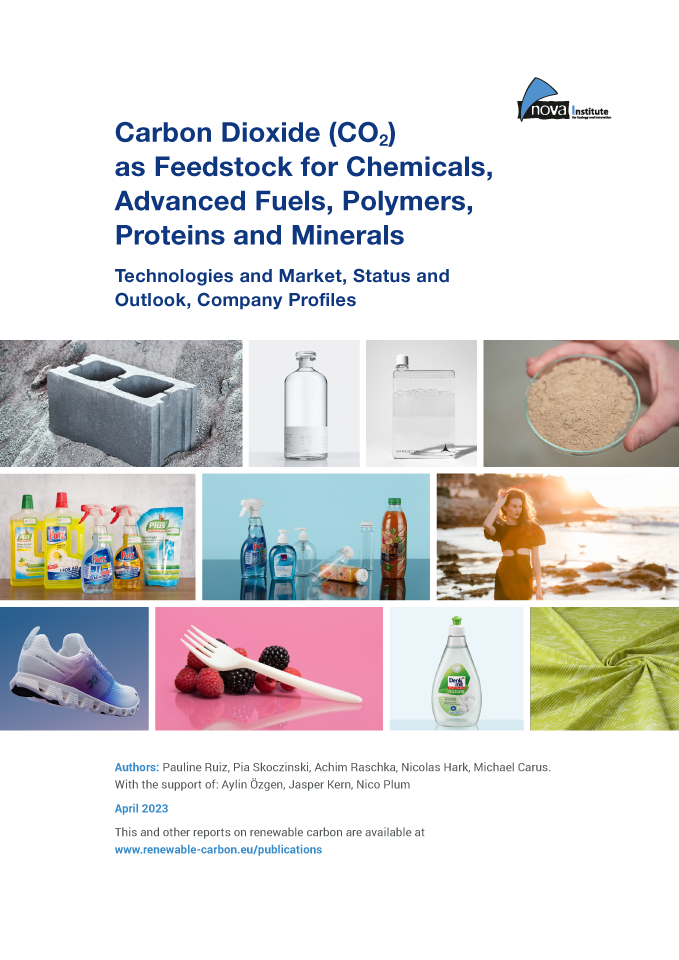
Report on the use of CO₂ for chemicals, advanced fuels, polymers, proteins and minerals by nova-Institute – A deep and comprehensive insight into the evolving technologies, trends and the dynamically growing market of CO2 transformation and utilisation.
Several successfully implemented technologies are now in commercial use, and many more are at the laboratory and pilot stage. A current total production capacity of novel CO2-based products of about 1.3 Mt/a in 2022 is observed. The production capacity in 2022 is dominated by the production of CO2-based aromatic polycarbonates, ethanol from captured CO/CO2, aliphatic polycarbonate and methanol. By 2030, the capacity outlook for CO2-based products is expected to exceed 6 Mt/a of CO2-based products. High dynamic growth is observed for methanol projects, methane plants, ethanol and hydrocarbons – the latter especially for the aviation sector. The potential of CCU has been recognised by several global brands which are already expanding their feedstock portfolio. However, in Europe, investments and prospects for CO2 utilisation are largely undermined by a lack of political support. In contrast, we see supportive policies in China as well as in the US with the Inflation Reduction Act. Such smart policies are needed to bridge the gap between now and 2050 for companies to remain competitive in the sustainable transformation.
All publications from the nova-Institute can be found here: https://renewable-carbon.eu/publications/
Source
nova-Institute, original text, 2024-06-11.
Supplier
Share
Renewable Carbon News – Daily Newsletter
Subscribe to our daily email newsletter – the world's leading newsletter on renewable materials and chemicals













